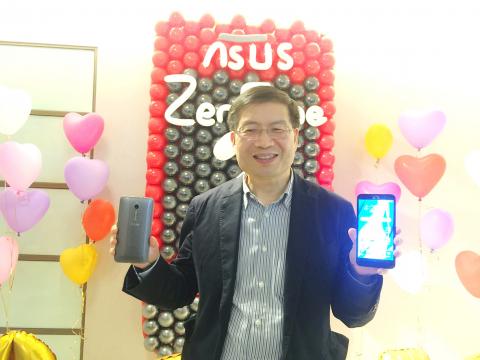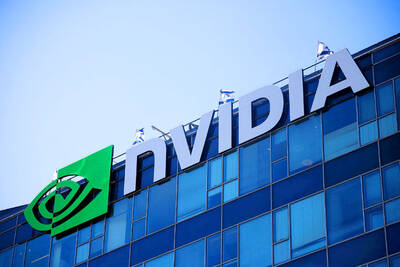Like most of its global competitors, such as Apple Inc, Asustek Computer Inc (華碩) is also counting on China to grow its new smartphone business and to hit its ambitious shipment target of 30 million units this year, more than tripling last year’s 8.5 million units.
Ahead of its official launch in Beijing today, the PC maker has about 2 million pre-sale orders for its latest flagship Zenfone 2 in China. That is a huge step for Asustek, which only sold between 600,000 and 700,000 smartphones in China last year.
“We hope the contribution from China will rise from last year’s 7 to 8 percent to 30 percent of total smartphone shipments this year,” Asustek chief executive Jerry Shen (沈振來) told reporters before a product launch in Beijing on March 27.

Photo: CNA
That translates into a shipment target of 9 million handsets in China this year.
China shipped a total of 420.7 million handsets last year, market researcher International Data Corp (IDC) said. Shipments are expected to grow 10 percent year-on-year to more than 462 million units this year, IDC said.
Asustek’s shipment target of 9 million units could help the firm gain nearly a 2 percent share of the Chinese market this year.
The company has raised its global smartphone shipments forecast three times in two months because of its optimism about the Chinese market.
At an investors’ conference in February, Shen said the smartphone business would become profitable when the firm ships more than 12 million units and that it expects to sell more than 17 million units by the end of this year.
During a Zenfone 2 product launch in Taiwan last month, Asustek chairman Jonney Shih (施崇棠) said the firm aims to triple its global smartphone shipments to 25 million units this year.
Two weeks later, Shih said he sees the company selling 30 million handsets this year.
Asustek chief financial officer David Chang (張偉明) told the Taipei Times that Shih raised the shipment target to 30 million units mainly because the company believes its new flagship product will be a great success in China.
“Zenfone 2 is the first and only smartphone that offers 4GB RAM globally. That unique spec has caught the eye of consumers,” Chang said, citing an enthusiastic response to the handsets in China, Taiwan and Europe.
Chang said 80 percent of global demand for the Zenfone 2 is for the 4GB RAM model, which is a good thing for the company because the model is priced higher and has a higher margin compared with the firm’s other handsets.
To gain a market share in China, Chang said Asustek last year launched the sub-brand Pegasus smartphone, which uses chips made by Qualcomm Inc and MediaTek Inc (聯發科), targeting the lower-priced segment of the market.
Expanding to the higher-priced segment this year, the company expects the mid-range 5.5-inch Zenfone 2, which is equipped with an Intel Corp processor, to complete a range of smartphones in the market and drive the firm’s sales performance, Chang said.
Generally, Intel processors cost more than those made by Qualcomm or MediaTek, but Intel is the only firm capable of making 4GB RAM available at the moment. Asustek plans to adopt Qualcomm’s processor when it is able to match Intel’s technology, Chang said.
The cost of the processor affects a smartphone’s price strategy and the product’s margin.
The Pegasus is priced between 899 yuan and 999 yuan (US$146 and US$163), while the Zenfone is priced at 2,000 yuan, the company said.
As part of its sales strategy, Asustek has partnered with Chinese telecoms to sell the Pegasus, while Zenfone 2 would be available via local retailers and online shopping sites, the company said.
At the end of last year, Asustek invited Chinese telecommunication equipment provider ZTE Corp’s (中興通訊) former vice president Wang Yong (王勇), who has wide experience with Chinese telecoms and retailers, to be Asustek’s deputy general manager for its Chinese smartphone business.
Asustek’s smartphone segment accounted for 17 percent of the firm’s total revenues of NT$477.4 billion (US$15.25 billion) last year, Shen said, adding that the company hopes the revenue contribution from the segment would grow to 30 percent this year on the back of growing demand in Taiwan and emerging markets.
“We hope the smartphone segment will account for more than 50 percent of our total sales by 2017, contributing more revenue than our PC products,” Shen said.

GROWING OWINGS: While Luxembourg and China swapped the top three spots, the US continued to be the largest exposure for Taiwan for the 41st consecutive quarter The US remained the largest debtor nation to Taiwan’s banking sector for the 41st consecutive quarter at the end of September, after local banks’ exposure to the US market rose more than 2 percent from three months earlier, the central bank said. Exposure to the US increased to US$198.896 billion, up US$4.026 billion, or 2.07 percent, from US$194.87 billion in the previous quarter, data released by the central bank showed on Friday. Of the increase, about US$1.4 billion came from banks’ investments in securitized products and interbank loans in the US, while another US$2.6 billion stemmed from trust assets, including mutual funds,

AI TALENT: No financial details were released about the deal, in which top Groq executives, including its CEO, would join Nvidia to help advance the technology Nvidia Corp has agreed to a licensing deal with artificial intelligence (AI) start-up Groq, furthering its investments in companies connected to the AI boom and gaining the right to add a new type of technology to its products. The world’s largest publicly traded company has paid for the right to use Groq’s technology and is to integrate its chip design into future products. Some of the start-up’s executives are leaving to join Nvidia to help with that effort, the companies said. Groq would continue as an independent company with a new chief executive, it said on Wednesday in a post on its Web

JOINT EFFORTS: MediaTek would partner with Denso to develop custom chips to support the car-part specialist company’s driver-assist systems in an expanding market MediaTek Inc (聯發科), the world’s largest mobile phone chip designer, yesterday said it is working closely with Japan’s Denso Corp to build a custom automotive system-on-chip (SoC) solution tailored for advanced driver-assistance systems and cockpit systems, adding another customer to its new application-specific IC (ASIC) business. This effort merges Denso’s automotive-grade safety expertise and deep vehicle integration with MediaTek’s technologies cultivated through the development of Media- Tek’s Dimensity AX, leveraging efficient, high-performance SoCs and artificial intelligence (AI) capabilities to offer a scalable, production-ready platform for next-generation driver assistance, the company said in a statement yesterday. “Through this collaboration, we are bringing two

Even as the US is embarked on a bitter rivalry with China over the deployment of artificial intelligence (AI), Chinese technology is quietly making inroads into the US market. Despite considerable geopolitical tensions, Chinese open-source AI models are winning over a growing number of programmers and companies in the US. These are different from the closed generative AI models that have become household names — ChatGPT-maker OpenAI or Google’s Gemini — whose inner workings are fiercely protected. In contrast, “open” models offered by many Chinese rivals, from Alibaba (阿里巴巴) to DeepSeek (深度求索), allow programmers to customize parts of the software to suit their